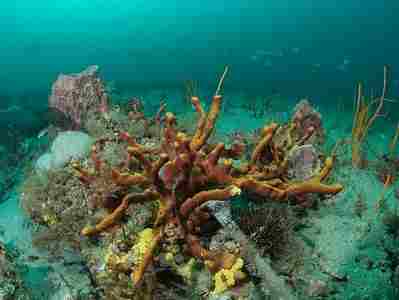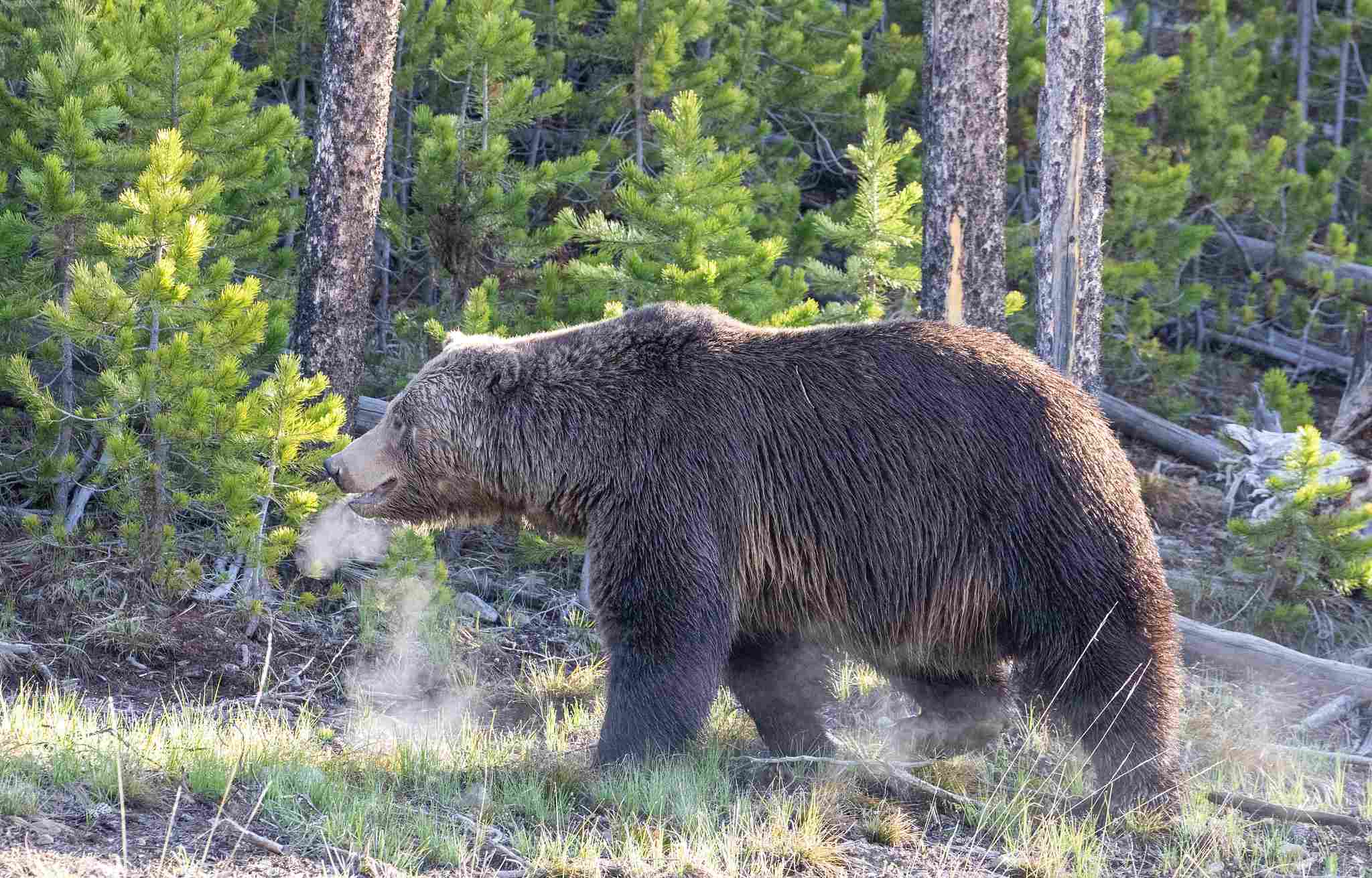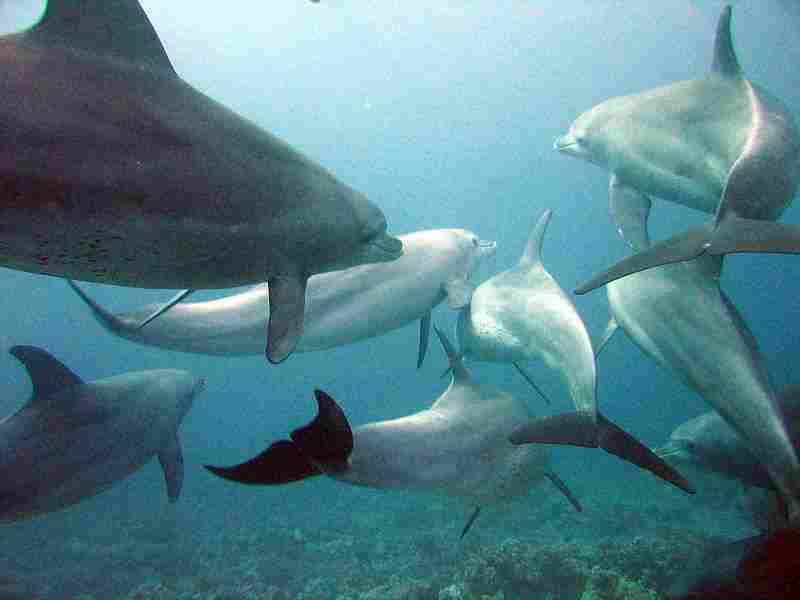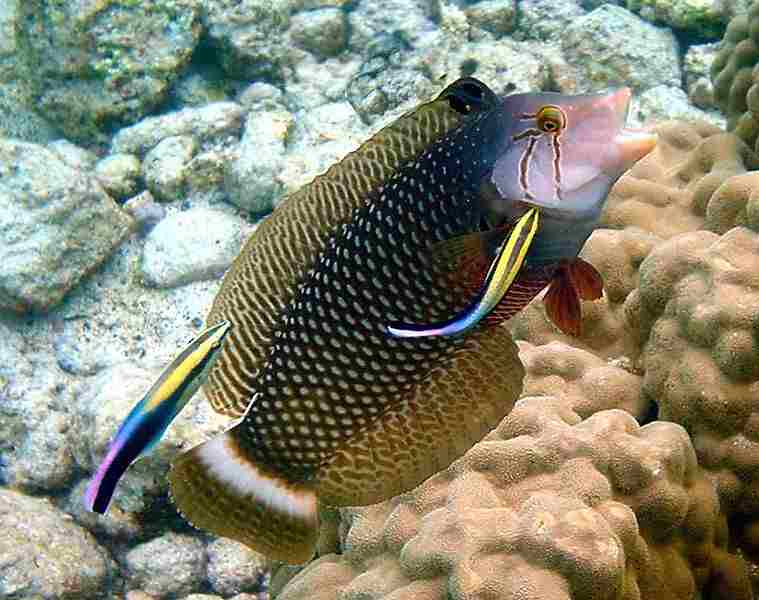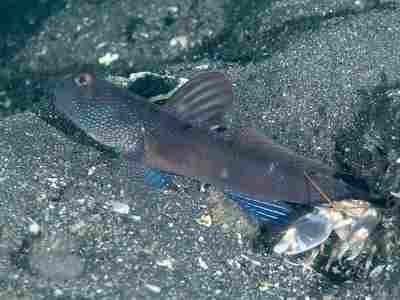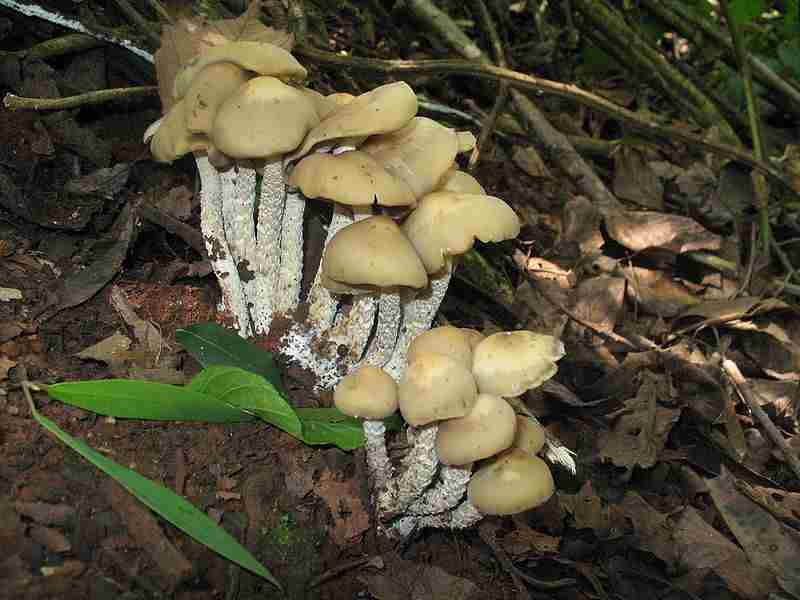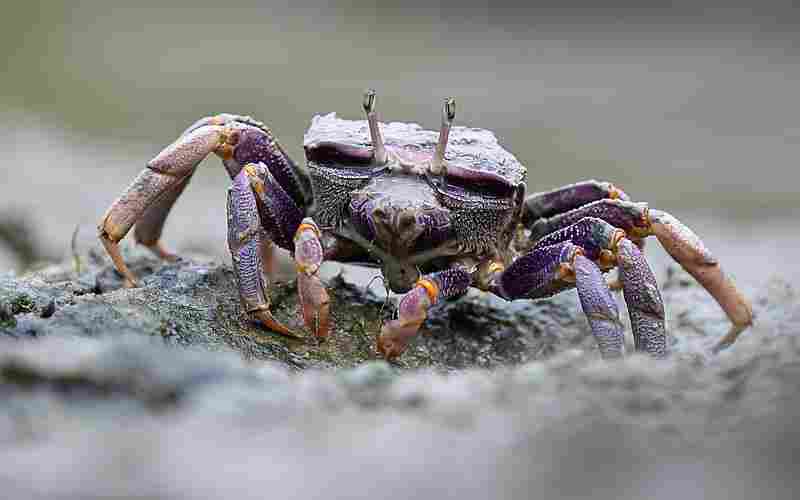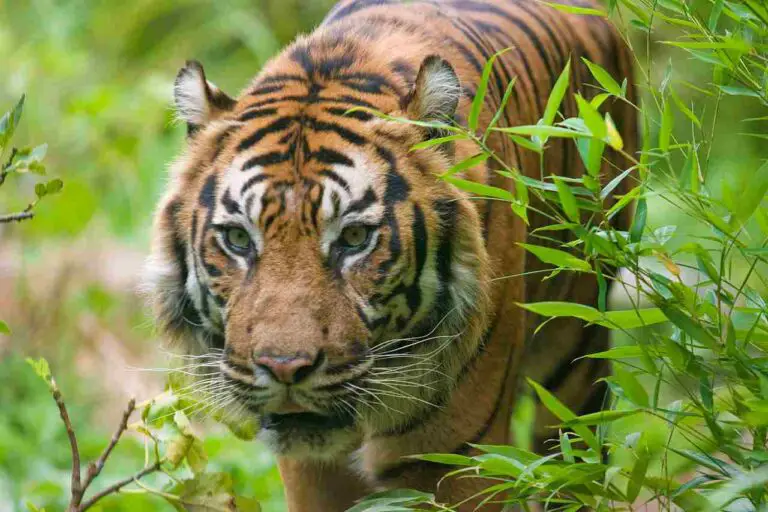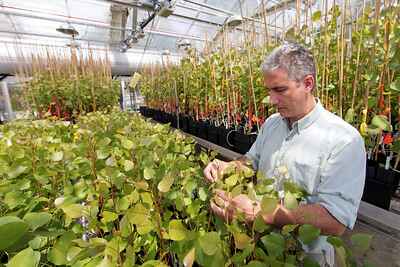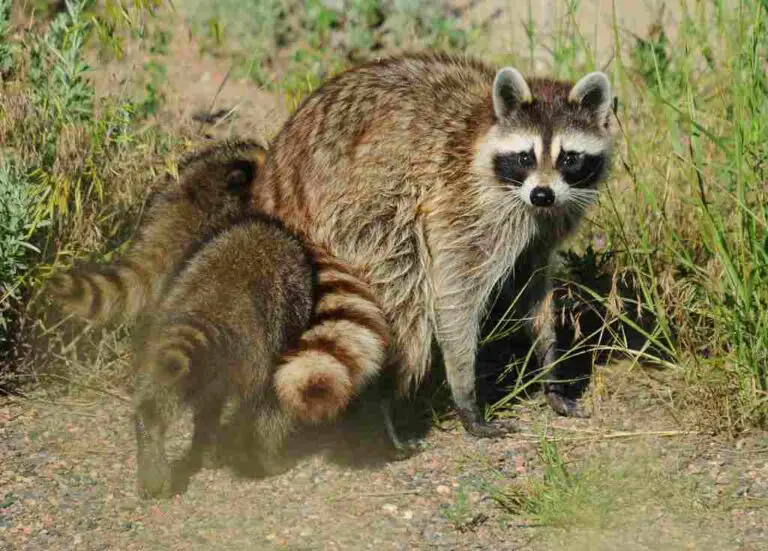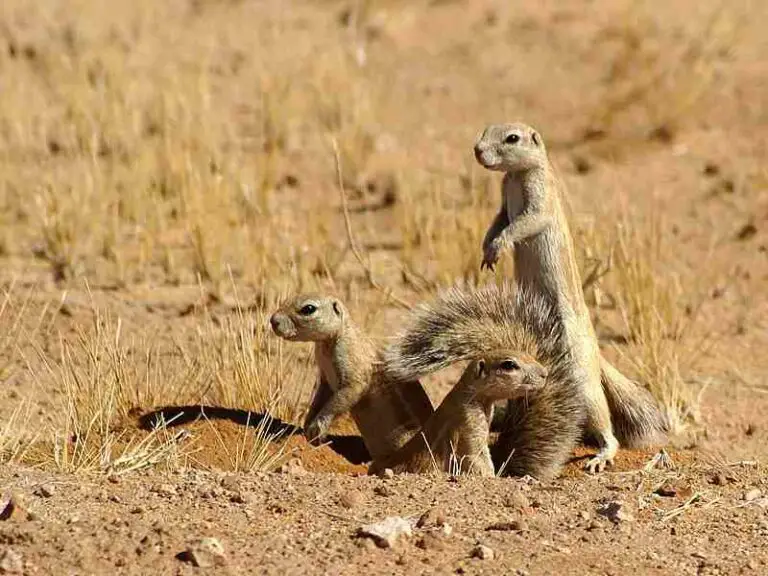11 Kelp Forest Biotic Factors and Their Functions
Kelp forest biotic factors are; producers/autotrophs, herbivores, carnivores, omnivores, decomposers, mutualism, commensalism, parasitism, competition, predation, and adaptation.
This article discusses kelp forest biotic factors and their functions, as follows;
1). Producers/Autotrophs in a Kelp Forest (as one of the Kelp Forest Biotic Factors)
Producers, or autotrophs, are important in kelp forest ecosystems because they form the foundational layer of the food chain.
These primary producers are solely responsible for converting solar energy into chemical bioenergy (stored in organic matter/biomass) through photosynthesis, which implies that they are vital to the entire ecosystem.
Some of the functions and characteristics of producers in a kelp forest are discussed within this section.
Characteristics and Functions of Kelp Forest Producers
Kelp forest producers are photosynthetic organisms that form the foundation of the marine food chain/web, utilize and recycle nutrients, while contributing to ecosystem productivity.
Producers in a kelp forest comprise of a variety of photosynthetic organisms, which include phytoplankton (microscopic marine algae), kelp macroalgae such as giant kelp (Macrocystis) and other kelp species like bull kelp (Nereocystis), feather boa kelp (Egregia) and oarweed (Laminaria) [2]. Red algae, including Turkish towel (Gigartina) and coralline algae (Corallina), are also part of the producer group.

In the kelp forest food web, producers serve as the foundational level organisms. They harness light energy from the sun, which they use to drive photosynthetic reactions that produce organic compounds. These organic compounds, being rich in carbon, become the primary energy resource and nutrient base for the entire ecosystem.
Like terrestrial autotrophs, kelp and other primary producers in the kelp forest, require essential nutrients, including phosphorus, potassium and nitrogen, for their survival, growth and reproduction. The availability of these nutrients (which can vary seasonally with environmental changes), influences the productivity of kelp and its associated autotrophic organisms.
In particular, kelp tends to thrive under a specific set of abiotic conditions. Ideal growth conditions for kelp forests include the presence rocky ocean bottom substrates for attachment, ample light availability for photosynthesis, as well as cold, clear, and nutrient-rich waters. These conditions collectively promote the optimal growth of kelp, which can form dense underwater forests.
Producers, including kelp and other (especially macroscopic) autotrophs, are not only the base of the food web, but also serve as microhabitat and a source of food for various organisms within the kelp forest [7]. They contribute to the overall productivity, species richness, and biodiversity of the ecosystem.
Overview of Kelp Forest Producers and Their Growth Requirements
Producers in a kelp forest include phytoplankton, various kelp species (like giant kelp, bull kelp), red algae (coralline algae, Turkish towel), and other less-dominant photosynthetic organisms.
Kelp's needs as a producer are; sunlight for photosynthesis, rocky bottom substrates for attachment, and access to cold, nutrient-rich, and clear waters. It also requires essential nutrients like potassium, sulfur, nitrogen and phosphorus for its growth and sustainability.
The ideal abiotic conditions for the growth of kelp forests include availability of rocky substrates for attachment, sufficient light intensity, low turbidity, cold water temperatures, and the presence of essential nutrients, especially nitrogen and phosphorus. These conditions all support the robust growth of kelp, and the overall wellbeing of the ecosystem.
2). Herbivores in a Kelp Forest
Herbivores within a kelp forest ecosystem, play a key role in establishing and modifying the community structure, as well as in maintaining the health of the ecosystem.
These organisms are typically responsible for consuming primary producers, such as phytoplankton, kelp and other macroalgae.
Here, the functions and characteristics of herbivores in a kelp forest are concisely discussed.
Functions and Characteristics of Herbivores in a Kelp Forest
In a kelp forest, herbivores function as primary consumers, control primary producer growth, contribute to biodiversity, exert top-down control, and may pose overgrazing risks to the ecosystem.
As stated above, herbivores are primary consumers within the kelp forest food chain. They feed mainly and/or solely on autotrophic organisms; primarily kelp, as well as other forms of micro and macroalgae (and in some cases, halophytes). This consumption of autotrophic material is a critical step that contributes to the dynamic of energy transfer through the ecosystem.
Herbivores help to regulate the abundance of kelp and other types of algae within the ecosystem. By feeding on these primary producers, they prevent unchecked/excessive growth (which may have negative ecological effects and environmental impacts) and maintain a state of balance in the kelp forest community.
Through their presence, herbivores in the kelp forest contribute to biodiversity, while creating multiple niches and survival opportunities for diverse species. Various herbivorous organisms, including kelp crabs, some isopods like genus Idotea (that consume large amounts of seaweed [9]), gastropods, and herbivorous fish, fulfill different important roles within the ecosystem.
Some degree of top-down control is exerted by herbivores on the kelp forest ecosystem. Feeding habits of these organisms can influence the composition and species abundance of both primary producers and other related organisms within the community.
Large assemblages of herbivores, such as sea urchins, can significantly impact the ecology of kelp forests. Overgrazing by these herbivores, if not controlled, can prevent kelp autotrophs from growing large enough to form dense forest structures. This phenomenon can lead to major shifts in the ecosystem structure.
List of Herbivores in the Kelp Forest
Herbivores in the kelp forest include crustaceans like kelp crabs and isopods, gastropod mollusks, and herbivorous fish. These herbivores mainly consume kelp and other macroalgae, and are crucial role in sustaining the ecosystem's dynamics.

3). Carnivores in a Kelp Forest (as one of the Kelp Forest Biotic Factors)
Carnivores in a kelp forest ecosystem are an integral part of the food chain/web, due to the crucial roles which they play in establishing the community structure, and controlling population dynamics.
These carnivorous organisms feed on various prey species, which include herbivores and smaller carnivores. Some of the functions and characteristics of carnivores in a kelp forest are discussed below.
Functions and Characteristics of Carnivores in a Kelp Forest
Carnivores in a kelp forest contribute immensely to predator-prey dynamics, while serving as keystone species, fostering biodiversity, and facilitating energy transfer.
The apex predators in kelp forests usually include carnivores. These organisms occupy the highest trophic levels, from which they play an effective role in regulating the populations of other (lower) organisms.
Predator-prey dynamics in kelp forests will not occur without carnivores. Carnivores help to regulate the populations of herbivores and detritivores among other lower organisms, which can have a substantial impact on the composition/resourcefulness of kelp forests. By preying on lower organisms, the carnivores indirectly protect kelp from overgrazing, and maintain a state of resource-equilibrium in the ecosystem.
Carnivores contribute to the biodiversity of the kelp forest, by facilitating coevolution and creating niches for different species. Various carnivorous organisms, including sea lions, seals, sharks, orca whales, king crabs, and rockfishes, fulfill different roles in the ecosystem.
Some carnivores, such as sea otters, are considered keystone species in kelp forests. Keystone species have a disproportionately large impact on the structure, composition and functionality of the ecosystem.
For example, sea otters feed on sea urchin which are known to graze heavily on kelp [5]. This means that shifts in the abundance and spatial distribution of the otters can affect the populations of sea urchins, kelp, and all associated organisms.
Carnivores are essential for sustaining the flow of energy through the kelp forest food web. They obtain their own energy from the biomass of prey organisms and, in turn, contribute to nutrient-recycling and energy transfer within the ecosystem when they release waste materials or die and undergo biodegradation.
Overview of Carnivores and Consumers in the Kelp Forest
Carnivores that are in in the kelp forest include sea otters, sea lions, seals, sharks, orcas, king crabs, and rockfishes. These carnivores play different roles in the ecosystem, which range from controlling lower organic populations to maintaining biodiversity.
Asides the king crab, others like the kelp crab (which is primarily herbivorous) can display occasional carnivorous behavior. For kelp crabs, carnivorous feeding is most common during the winter, during which it may prey on barnacles, mussels, and bryozoans among other organisms. This implies that kelp crabs are fit for classification as omnivores, in some contexts.
Three consumer groups in the kelp forest are; herbivores, carnivores and omnivores, which feed on autotrophs, heterotrophs, and combined food sources respectively.
Invertebrate organisms like gastropods, and some species of fish that consume primary producers such as kelp and microalgae, are the herbivores. Some
Predatory animals like sea otters, sea lions, seals and sea stars that feed on both herbivores and smaller/vulnerable carnivores.
Apex predators that traverse the kelp forest zone include orcas, sharks, and other large fish, which occupy the highest trophic level(s) and feed on other consumers.
4). Omnivores in a Kelp Forest
Omnivores in a kelp forest ecosystem are unique and versatile in their roles, mainly because they have the capacity to consume both plant and animal biomass.
Here, some of the functions and characteristics of omnivores in a kelp forest are highlighted.
Functions and Characteristics of Omnivores in a Kelp Forest
Kelp forest omnivores are known for their dietary flexibility, and contribute to nutrient cycling, ecosystem balance, biodiversity, and energy transfer.
As already stated, omnivores have a broad diet that comprises of both plant and animal resources. In the context of a kelp forest, this dietary flexibility allows the omnivores to consume a wide range of food materials, including algae, detritus, small invertebrates, and vertebrates like fish.
By consuming both plant and animal biomass, omnivores help in the recycling of nutrients within the kelp forest ecosystem. They break down organic materials through digestion, and release nutrients (from these materials) back into the environment through their waste, thereby contributing to the overall process of nutrient cycling in their habitat.
Omnivorous organisms can influence the population-abundance of both primary producers (like kelp) and herbivores (like gastropods) in the ecosystem. Their feeding habits can help to maintain a state of equilibrium between these groups, preventing overgrazing and overgrowth of autotrophs, as well as overpopulation of herbivores. This can have far-reaching effects with regards to mitigating the risk of resource depletion.
By occupying a unique and versatile niche, omnivores contribute to the diversity of species within the kelp forest. They interact with various groups of organisms and, in doing so, help sustain multiple populations.
Lastly, omnivores serve as intermediaries in the sequence of energy transfer through the kelp forest food web. They acquire their energy from both autotrophic and heterotrophic sources and, in turn, provide a source of energy to more-advanced consumers in higher trophic levels (which prey on the omnivores).
Overview of Omnivores and Key Organic Groups in Kelp Forests
Some omnivores that live in kelp forests are; kelp crabs (due to their seasonal dietary adjustments), sea urchin, and some species of fish that have flexible diets, such as certain gobies. These organisms consume a combination of autotrophic material (like seaweeds and phytoplankton) and animal matter (like small invertebrates).

The four key organisms in a kelp forest ecosystem are; primary producers; herbivores, carnivores, and omnivores.
Primary producers include kelp, other macroalgal species, halophytes and phytoplankton, that form the foundation of the food chain/energy pyramid.
Herbivores include organisms like gastropods and herbivorous fish that consume the autotrophic primary producers.
Carnivores are predatory individuals like sea otters and sharks that feed exclusively on other heterotrophs.
Omnivores are versatile eaters like kelp crabs and some species of fish that have omnivorous diets, and may consume both plant and animal material.
5). Decomposers in a Kelp Forest (as one of the Kelp Forest Biotic Factors)
Decomposers in a kelp forest ecosystem are a critical biotic component, which is responsible for breaking down the remains and waste of organisms, recycling nutrients, and fostering resource efficiency within the ecosystem.
Here, the functions and characteristics of decomposers in a kelp forest are discussed concisely.
Functions and Attributes of Kelp Forest Decomposers
The functions and attributes of decomposers in a kelp forest ecosystem are; nutrient recycling, detritus processing, energy flow-facilitation, maintenance of water quality, and support of benthic communities.
Decomposers are highly effective in the recycling of essential nutrients such as carbon, potassium, nitrogen, sulfur, and phosphorus. They contribute to this phenomenon by breaking down the remains of kelp, detritus, and other organic materials, transforming these into simpler forms that can be taken up and absorbed by primary producers like macroalgae and phytoplankton [6].
Detritus formation and processing are two related phenomena that can be attributed to the activities of decomposers. These organisms including bacteria and fungi, break down dead organisms and excrement that fall to the ocean floor. This decomposition process transforms complex organic molecules into partially-decomposed and granular matter, called detritus, which can mix with sediments, and serves as a food source for detritivores (organisms that feed on detrital organic matter)- that are classified as secondary decomposers.
By breaking down detritus, decomposers help release stored energy from organic matter. This energy then becomes available to other organisms in the food chain structure, so that decomposition supports the overall flow of energy through the ecosystem.
Water quality is partly maintained by decomposers, through the removal of organic matter from the environment. This can be seen as a form of natural water purification, as the decomposers prevent the accumulation of organic waste material on the ocean floor, which could cause the release of harmful substances and the degradation of water quality, if allowed to occur.
By producing partially-decomposed detrital substrate, decomposers provide a consistent source of food for benthic filter-feeders and scavengers, such as sponges and sea cucumbers. These organisms, in turn, contribute to the biodiversity and functional multiplicity, of the kelp forest ecosystem.
Examples of Kelp Forest Decomposers, and Environmental Influencing Factors
Decomposers in kelp forests include; fungi, bacteria, and detritivores like sea cucumbers. These organisms degrade organic waste, dead kelp, and detritus, thereby returning nutrients to the ecosystem for reuse.
Climate change is one of the main abiotic factors contributing to the decline of kelp forests on a global scale. It can lead to both abiotic stress (in the form of warming waters and ocean acidification) as well as disruptions in biotic interactions (such as changes in predator-prey dynamics) that negatively impact kelp populations.
Other abiotic factors that cause the loss of kelp are; changes in ocean circulation patterns (including wave and tidal influences) and pollution.
6). Mutualism in a Kelp Forest
Mutualism is a notable ecological relationship in a kelp forest ecosystem, where multiple species interact with each other in a mutually beneficial way.
These mutualistic interactions contribute to the stability and continuity of the ecosystem. A brief exploration of mutualism in a kelp forest is contained in this section.
Examples of Mutualism in the Kelp Forest Ecosystem
One of the most prominent examples of mutualism in a kelp forest occurs between sea otters and kelp. Sea otters help to maintain the health of the kelp forest ecosystem by regulating the sea urchin population, which, if left unchecked, can heavily consume kelp to the point of damaging the entire forest structure [8]. In return for their service, sea otters find food resources and shelter among the kelp, thereby establishing a mutually beneficial relationship.
There are multiple perspectives from which this relationship can be viewed. It can be considered a tri-component dynamic involving sea otters, kelp, and sea urchins. Sea otters feed on sea urchins, which in turn graze on kelp. By keeping the sea urchin population under control, sea otters indirectly protect the kelp forests from depletion through overgrazing, and help the kelp thrive.
It can also be viewed as an instance of trophic cascading; where the presence and activities of predatory organisms in high trophic levels affect producers at the bottom of the trophic hierarchy [1].
The relationship between sea otters and kelp is not a direct (or typical) symbiotic one, but rather an indirect dorm of mutualism. Sea otters use kelp as a source of shelter and food (which includes sea urchins). By consuming sea urchins, they prevent overgrazing of kelp by the urchins, thus indirectly aiding the survival of the kelps.

Functions of Mutualism in a Kelp Forest
Functions of Mutualism in a kelp forest are; ecosystem health maintenance, nutrient cycling, biodiversity support, and ecosystem stability.
Mutualistic relationships help to maintain the health and equilibrium of the kelp forest ecosystem, for example; by preventing overgrazing of kelp by sea urchins.
Sea otters indirectly contribute to nutrient cycling by preying on sea urchin populations, which can impact nutrient availability in the ecosystem.
Also, by protecting kelp, sea otters support the survival of a diverse array of species that rely on kelp as habitat.
Mutualism contributes to the complexity, stability and ecologic resilience of the kelp forest habitat, making it less susceptible to disturbances.
7). Commensalism in a Kelp Forest
Commensalism is a type of symbiotic relationship in which one organism benefits, and the other neither noticeably benefits nor is harmed.
Although commensalism is less common than mutualism, and less effective than competition in kelp forests, there are some interactions within this ecosystem that can be classified as commensalism.
Example(s) of Commensalism in Kelp Forests
In a kelp forest, a notable example of commensalism is the attachment of small organisms to kelp fronds for support. These organisms usually entwine themselves in kelp beds, using the kelp as an anchor to prevent drifting away in the current.
The kelp itself is not affected by this interaction; it neither benefits nor is harmed. In contrast, the attached organisms gain a significant advantage from this behavior by avoiding displacement or physical harm/mortality.
Functions of Commensalism in a Kelp Forest
Functions of commensalism in a kelp forest include; provision of stability and safety, energy conservation, and facilitation of adaptation.
The use of kelp as an anchor by organisms, provides stability and safety during their activities, ans reduces the risk of drifting away or being harmed by the impact of ocean currents.
By anchoring themselves with kelp beds, organisms can conserve energy, as they do not need to constantly swim to stay in place. This energy is therefore available to be used for ecosystem building and procreation.
Commensalism and the need to survive fosters the development of useful adaptations in both autotrophs and heterotrophs in the kelp forest.
8). Parasitism in a Kelp Forest
Parasitism is a type of symbiotic relationship in which one organism; called the parasite, benefits by gaining resources at the expense of the host organism [12]. In a kelp forest ecosystem, there are various parasites that are capable of impacting the health and interactions of inhabitant organisms .
This section provides an overview of parasitism in a kelp forest, along with some examples.
Examples of Parasitism in a Kelp Forest Ecosystem
An example of parasitism in the kelp forest is the infestation of thornback guitarfish by tapeworm (Echinobothrium californiense). The same fish species can also be parasitized by nematodes like Proleptus acutus.
Tapeworms can attach themselves firmly to the intestinal walls of the guitarfish, where they absorb nutrients from their host and potentially cause harm in the form weakness or mortality, to the host organism.
Parasites can significantly influence the trophic structure, and dynamics of kelp-forest food webs. By infesting various species within the ecosystem, parasites can increase the length, specialization, and complexity of the food chain. However, they may also reduce trophic connectivity by impairing host health, so that the interactions among species in the kelp forest may be altered and undermined.
Functions of Parasitism (in Kelp Forests)
Functions of parasitism in kelp forests include; regulation of species populations, alteration of food web dynamics, and disease transmission.
Parasites can help to regulate the populations of certain host species within the kelp forest ecosystem. By parasitizing these hosts, parasites can prevent their overpopulation, which can in turn have cascading effects on the entire ecosystem.
By creating additional trophic interactions, parasites introduce complexity into the food web. This complexity can affect the flow of energy and nutrients within the ecosystem in diverse ways.
Some parasites can function as viable vectors for diseases that affect organisms in the kelp forest. Their activities can lead to disease outbreaks that influence both population dynamics and overall community structure.
While parasitism is generally harmful to the host organism, it is still an important aspect of ecosystems like the kelp forest. It contributes to the regulation of species populations, influences the dynamics of food webs, and adds emphasis to the interconnectedness of species within the ecosystem.
9). Competition in a Kelp Forest (as one of the Kelp Forest Biotic Factors)
Competition can be described as a fundamental ecological process that occurs in kelp forests, and can be said to influence the trophic structure and dynamics of these underwater ecosystems.
In a kelp forest, competition mainly involves a scenario where plants and animals vie for limited resources, such as light, space, food materials and nutrients. An overview of competition in a kelp forest, and its effects are discussed in this section.
Overview of Competition for Resources in Kelp Forests
Competition is often intense within kelp forest communities, as various organisms strive for access to resources that are essential for their growth and survival. These resources include; space, light, nutrients and food [4].
Kelp, like other sessile autotrophs, must compete for space to establish themselves. The availability of suitable substrate (usually rock surfaces) for attachment is crucial to kelps, and they are often involved in intraspecific and/or interspecific competition for space.

As kelp grows towards the surface of the water to reach sunlight for photosynthesis, it usually competes with nearby plants for access to this vital resource.
Availability of nutrients, especially nitrogen and phosphorus, can limit growth in kelp forests. Kelp also competes with other algae and organisms for these nutrients.
Competition for food resources can occur among herbivores, carnivores and omnivores that feed on kelp and other organisms in the ecosystem.
Effects of Competition on Kelp Forests
Effects of competition on kelp forests include changes in community structure, species interactions, ans population dynamics; all of which lead to spatial and temporal variability.
Community structure of kelp forests is significantly influenced by competition, which has a significant impact on kelp forest communities. It determines which species are able to assert dominance, which ones are relegated to subordinate roles, as well as how different organisms coexist within the ecosystem.
Interactions between species are influenced by competition. For instance, competition between kelp overgrowth and understory seaweeds, can indirectly affect sessile animals by altering the availability of substrate and shelter.
Population dynamics are also affected by competition, which exerts pressure that regulates population sizes and leads to fluctuations in the abundance of different species. For example, when sea urchins and gastropods compete for autotrophic food sources, it can affect the population dynamics of both.
Competition within kelp forests, can vary on both spatial and temporal scales. Factors such as nutrient availability, hazardous events, and the presence of herbivores can all influence the intensity of competition in different areas and at different times.
10). Predation in a Kelp Forest
Predation is a vital ecological process that occurs in kelp forests, with various organisms serving as both predators and prey. Predation has an influence over the structure, functionality and dynamics of kelp forest ecosystems in several ways.
Functions of Predation in Kelp Forests
Predation is important in kelp forests due to its influence on trophic relations, prey population control, ecosystem structuring, habitat protection, conservation and natural management.
In a kelp forest, a range of predatory organisms feed on different prey species. Some common examples of predators in kelp forests are; sea otters, seahorse, sunflower sea stars, catsharks, sea lions, seals, and certain fish species.
Generally, predators play a critical role in regulating the populations of their prey. This can be observed from an earlier-mentioned scenario, where sea otters act as voracious predators of sea urchins, which are in turn herbivores that graze on kelp.
By consuming the sea urchins, sea otters help to control their populations, and thereby prevent the overgrazing of kelp. This top-down control of herbivore populations ensures the sustainability and health of the kelp forest.
Through its various impacts, predation can influence the overall trophic structure of kelp forests. For instance, the presence or absence of sea otters can reduce or increase the abundance of sea urchins, which, in turn, affects the density of kelp. In the absence of the sea otters, sea urchin populations can explode, leading to the overconsumption of kelp, and the depletive transformation of kelp forests into urchin barrens, which are areas devoid of algal biomass.
Kelp forests provide an essential habitat for various marine species. Many of these animals, including seals, sea lions, and catsharks, use kelp fronds for anchorage, and blades to shelter their young and hide from storms or predators. For sea otters, kelp can serve as an anchor, which prevents them from drifting away while they sleep [11].
Predation can serve as a tool for conservation efforts. For example, managing the populations of predators, such as sea otters, can be an essential measure for the protection and restoration of prey populations in kelp forests. On the other hand, by controlling herbivore populations, predators help to conserve autotroph communities, thereby maintaining the overall functionality and biodiversity of these ecosystems.
While predation by native species often contributes positively to the equilibrium of kelp forests, invasive predators, or gross imbalances in predator-prey relationships can pose an ecological threat.
11). Adaptation in a Kelp Forest (as one of the Kelp Forest Biotic Factors)
Adaptation is a critical biological factor that is functional in kelp forests, as these underwater ecosystems are home to a diverse range of species, which include the dominant giant kelp (Macrocystis pyrifera).
Adaptations in kelp and other organisms, are essential for their survival and ecological success within this dynamic marine environment. This section addressed why adaptation is vital in a kelp forest ecosystem, and highlights a few of such organic adaptations.
Unique Adaptations of Kelp
The unique adaptations of kelp include; gas-filled bladders for buoyancy, and thin, blade-like leaves for large surface area.
One of the most prominent adaptations of kelps is the possession of gas-filled bladders, also known as pneumatocysts [3]. These bladders provide the algae with buoyancy, which allows them to remain upright in the water column, and ensures that their photosynthetic blades receive sufficient amount of sunlight for photosynthesis. The pneumatocyst adaptation helps kelp maximize their energy production as autotrophs.
Kelp also possesses thin and blade-like leaves that increase the surface area which is available for photosynthesis. This adaptation enables them to maximize sunlight capture, while growing in the submerged marine environment.
Role of Adaptation in Ecosystem Dynamics
Adaptation of kelps creates organic habitat and shelter, while providing a food source. The adaptations of other organisms inhabiting kelp forests, increase their survival rate, trophic connectivity, and overall effectiveness as biotic factors of the ecosystem.
Kelp forests are renowned for their high biodiversity, as they host various species of plants and animals. Kelp blades serve as shelter for many small marine species, including young fish and invertebrates seeking refuge from predators and/or rough conditions.
The adaptations of kelp contribute to the overall wellbeing and productivity of the ecosystem. By providing an essential habitat, and serving as a primary producer, kelp supports a relatively-robust food web that comprises of multiple herbivores, predators, and scavengers. This web of trophic interactions, sustains the kelp forest and, by extension, the broader marine terrain.
Survival Strategies of Kelp Forest Organisms
Organisms in the kelp forest survive through adaptations like flexible stipe and holdfast, distinctive behaviors, and dietary capabilities.
The holdfast; which is a strong root-like structure, and the flexible stipe (a stem-like structure) are two important structural adaptations that help kelps to remain anchored in their spatial territory. These adaptations prevent the kelps from being easily dislodged by strong waves or laminar currents, and ensure their stability and continued growth.
Various organisms within the kelp forest exhibit behavioral adaptations that facilitate survival. For example, some fish species, like lingcod, exhibit (seasonal) territorial behaviors to secure their food sources and shelter [10]. Sea otters display learned/evolved behavior in anchoring themselves among kelp fronds to prevent drifting and predation.
Conclusion
Kelp forest biotic factors are;
1. Producers/Autotrophs
2. Herbivores
3. Carnivores
4. Omnivores
5. Decomposers
6. Mutualism
7. Commensalism
8. Parasitism
9. Competition
10. Predation
11. Adaptation
References
1). Aaron, E.; Julia, B. (2020). "Trophic cascades in coastal marine ecosystems: a meta-analysis of experimental and observational research." Available at: https://doi.org/10.32942/osf.io/vbn3x. (Accessed 14 September 2023).
2). Amira, A. (2019). "Reconstructing Nearshore and Kelp Forest Habitats from Trans-Holocene Occupations at Bay Point, San Miguel Island, California: The Archaeology and Historical Ecology of Daisy Cave and Cave of the Chimneys." Available at: https://scholarsbank.uoregon.edu/xmlui/handle/1794/24874. (Accessed 14 September 2023).
3). Burnett, N. P.; Koehl, M. A. R. (2017). "Pneumatocysts provide buoyancy with minimal effect on drag for kelp in wave-driven flow." Journal of Experimental Marine Biology and Ecology 497:1-10. Available at: https://doi.org/10.1016/j.jembe.2017.09.003. (Accessed 14 September 2023).
4). Edwards, M.; Connell, S. D. (2012). "Competition, a Major Factor Structuring Seaweed Communities." Seaweed Biology (pp.135-156). Available at: https://doi.org/10.1007/978-3-642-28451-9_7. (Accessed 14 September 2023).
5). Estes, J. A.; Doak, D. F.; Springer, A. M.; Williams, T. M. (2009). "Causes and consequences of marine mammal population declines in southwest Alaska: a food-web perspective." Philos Trans R Soc Lond B Biol Sci. 2009 Jun 27;364(1524):1647-58. Available at: https://doi.org/10.1098/rstb.2008.0231. (Accessed 14 September 2023).
6). Eyre, B.; Ferguson, A. (2002). "Comparison of carbon production and decomposition, benthic nutrient fluxes and denitrification in seagrass, phytoplankton, benthic microalgae- and macroalgae- dominated warm-temperate Australian lagoons." Marine Ecology Progress Series. Available at: https://www.semanticscholar.org/paper/Comparison-of-carbon-production-and-decomposition%2C-Eyre-Ferguson/46e3c3711e6289c1df5cc7a19d095cb55fa966e0. (Accessed 14 September 2023).
7). Harry, T.; Stephen, H.; Pippa, M.; Dan, S. (2017). "The role of kelp species as biogenic habitat formers in coastal marine ecosystems". Journal of Experimental Marine Biology and Ecology. 492. Available at: https://doi.org/10.1016/j.jembe.2017.01.017. (Accessed 14 September 2023).
8). Kjell, N.; Christie, H. (2009). "Sea urchin grazing and kelp re-vegetation in the NE Atlantic." Marine Biology Research - MAR BIOL RES. 5. 515-528. Available at: https://doi.org/10.1080/17451000902932985. (Accessed 14 September 2023).
9). Korez, Š.; Gutow, L.; Saborowski, R. (2019). "Feeding and digestion of the marine isopod Idotea emarginata challenged by poor food quality and microplastics." Comp Biochem Physiol C Toxicol Pharmacol. 2019 Dec;226:108586. Available at: https://doi.org/10.1016/j.cbpc.2019.108586. (Accessed 14 September 2023).
10). Longo, G. C.; Lam, L.; Basnett, B.; Samhouri, J.; Hamilton, S.; Andrews, K.; Williams, G.; Goetz, G.; McClure, M.; Nichols, K. M. (2020). "Strong population differentiation in lingcod (Ophiodon elongatus) is driven by a small portion of the genome." Evol Appl. 2020 Jun 29;13(10):2536-2554. Available at: https://doi.org/10.1111/eva.13037. (Accessed 15 September 2023)..
11). Nielsen, L. (2013). "Sea otters and kelp forests helping you." Available at: https://frontierscientists.com/2013/10/sea-otters-kelp-forests-helping-you/. (Accessed 15 September 2023).
12). Thompson, S. N.; Kavaliers, M. (1994). "Physiological bases for parasite-induced alterations of host behaviour." Parasitology. 1994;109 Suppl:S119-38. Available at: https://doi.org/10.1017/s0031182000085139. (Accessed 14 September 2023).



